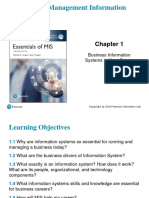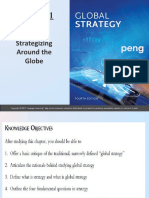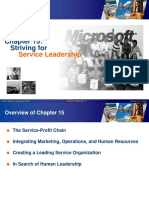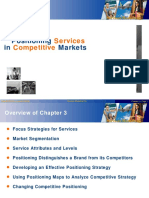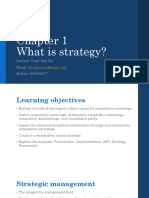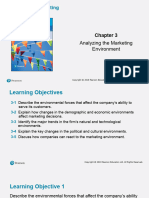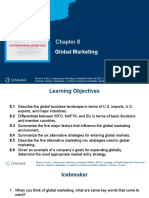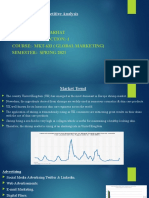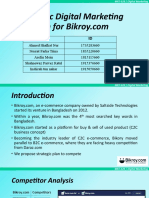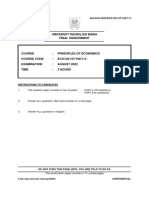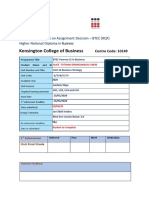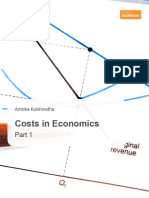CHAPTER 7
STRATEGY AND TECHNOLOGY
©2015 Cengage Learning. All Rights Reserved. May not be scanned, copied or duplicated, or posted to a publicly accessible website, in whole or in part.
�LEARNING OBJECTIVES
▪ Understand the tendency toward standardization
in many high-technology markets
▪ Describe the strategies that firms can use to
establish their technology as the standard in a
market
▪ Explain the cost structure of many high-
technology firms, and articulate the strategic
implications of this structure
▪ Explain the nature of technological paradigm
shifts and their implications for enterprise
strategy
2
�TECHNICAL STANDARDS AND FORMAT
WARS
Technical standards
• Set of technical specifications that producers adhere
to when making the product, or a component of it
Format wars
• Battles to control the source of differentiation, and the
value that such differentiation can create for the
customer
Dominant design
• Common set of features or design characteristics
3
�TECHNICAL STANDARDS FOR PERSONAL
COMPUTERS
4
�BENEFITS OF STANDARDS
▪ Guarantees compatibility between products and
their complements
▪ Reduces confusion in the minds of consumers
▪ Reduces production costs and risks associated
with supplying complementary products
▪ Leads to low-cost and differentiation advantages
for individual companies
▪ Helps raise the level of industry profitability
5
�ESTABLISHMENT OF STANDARDS
▪ Standards emerge in an industry when the
benefits of establishing are recognized
▪ Technical standards are set by cooperation
among businesses, through the medium of an
industry association
▪ When the government sets standards they fall
into the public domain
▪ Public domain: Any company can freely incorporate the
knowledge and technology upon which the standard is
based into its products
6
�NETWORK EFFECTS, POSITIVE
FEEDBACK, AND LOCKOUT
▪ Network effects: Network of complementary
products as a primary determinant of the
demand for an industry’s product
▪ Positive feedback loops - Increase in demand for
a technology that triggers an increase in demand
for products that support it
▪ Alternative standards get locked out as
consumers are unwilling to bear the switching
costs
7
�POSITIVE FEEDBACK IN THE MARKET
FOR VCRS
8
�STRATEGIES FOR WINNING A FORMAT
WAR
▪ Make network effects work in one’s favor and
against competitors
▪ Build the installed base for the standard as
rapidly as possible
1. Ensure a supply of complements
2. Leverage killer applications
▪ Killer applications: Applications or uses of a new
technology or product so compelling that customers
adopt them in droves, killing competing formats
9
�STRATEGIES FOR WINNING A FORMAT
WAR
3. Pursue aggressive pricing and marketing
Razor and blade strategy: Pricing the product low
to stimulate demand, and pricing complements
high
4. Cooperate with competitors
5. License the format
10
�COSTS IN HIGH-TECHNOLOGY
INDUSTRIES
▪ Similar cost economics
▪ Very high fixed costs and very low marginal costs
▪ Law of diminishing returns - Marginal costs rise
as a company tries to expand output
▪ Profitability increases when a company shifts
from a cost structure with increasing marginal
costs to higher fixed costs with lower marginal
costs
11
�COST STRUCTURES IN HIGH-
TECHNOLOGY INDUSTRIES
12
�FIRST MOVER
▪ Firm that pioneers a particular product category
or feature by being first to offer it to the market
▪ Creation of a revolutionary product results in a
monopoly position
▪ First-mover advantage - Pioneering new
technologies and products that lead to slowing
the rate of imitation
▪ First-mover disadvantages: Competitive
disadvantages associated with being first
13
�FIGURE 7.6 - THE IMPACT OF IMITATION
ON PROFITS OF A FIRST MOVER
14
�STRATEGIC IMPLICATIONS: CROSSING
THE CHASM
Advantages Disadvantages
• Opportunity to exploit • Bear significant pioneering
network effects and positive costs
feedback loops
• More prone to making
• Ability to establish brand mistakes
loyalty and increase sales
• Risk of building the wrong
volume ahead of rivals
resources and capabilities
• Ability to create switching
• Risk of investing in inferior or
costs for customers and
obsolete technology
accumulate knowledge
15
�STRATEGIES FOR EXPLOITING FIRST-
MOVER ADVANTAGES
▪ Develop and market the innovation
▪ Develop and market the innovation jointly with
other companies
▪ Through a strategic alliance or joint venture
▪ License the innovation to others and allow them
to develop the market
16
�FACTORS TO CONSIDER WHEN
SELECTING A STRATEGY
▪ Complementary assets
▪ Required to exploit a new innovation and gain a
competitive advantage
▪ Help build brand loyalty and achieve rapid market
penetration
▪ Height of barriers to imitation
▪ Higher the barriers, longer it takes for rivals to imitate
▪ Give the innovator more time to build an enduring
competitive advantage
17
�FACTORS TO CONSIDER WHEN
SELECTING A STRATEGY
▪ Capable competitors
▪ Companies that can move quickly to imitate the
pioneering company
▪ Competitors’ capability depends on their research and
development skills and access to complementary assets
18
�STRATEGIES FOR PROFITING FROM
INNOVATION
19
�TECHNOLOGICAL PARADIGM SHIFT
▪ Shifts in new technologies that:
▪ Revolutionize the structure of the industry
▪ Dramatically alter the nature of competition
▪ Require companies to adopt new strategies for survival
▪ Occur in an industry when:
▪ Established technology is approaching or is at its natural
limit
▪ New disruptive technology has entered the marketplace
and is invading the main market
20
�FIGURE 7.7 - THE TECHNOLOGY S-
CURVE
21
�FIGURE 7.8 - ESTABLISHED AND
SUCCESSOR TECHNOLOGIES
22
�FIGURE 7.9 - SWARM OF SUCCESSOR
TECHNOLOGIES
23
�STRATEGIC IMPLICATIONS FOR
ESTABLISHED COMPANIES
▪ Being aware of how disruptive technologies can
revolutionize markets is a valuable strategic asset
▪ Investing in new technologies that may become
disruptive technologies
▪ Creating an autonomous operating division
solely for the disruptive technology
24
�STRATEGIC IMPLICATIONS FOR NEW
ENTRANTS
▪ Do not face pressures to continue the existing
out-of-date business model
▪ Do not have to worry about established:
▪ Customer base
▪ Relationships with suppliers and distributors
▪ Can focus their energies on the opportunities
offered by the new disruptive technology
▪ Must decide whether to partner with an
established company or go solo
25
�NEXT SESSION:
MID-TERM
EXAMINATION I
26












